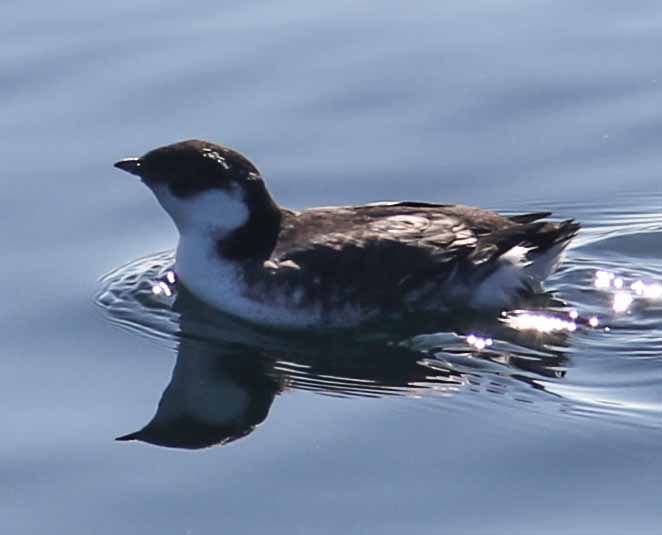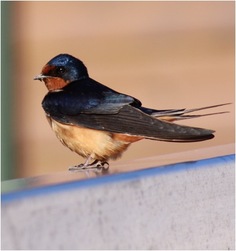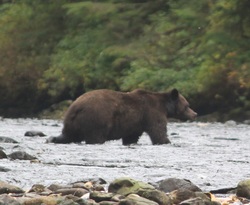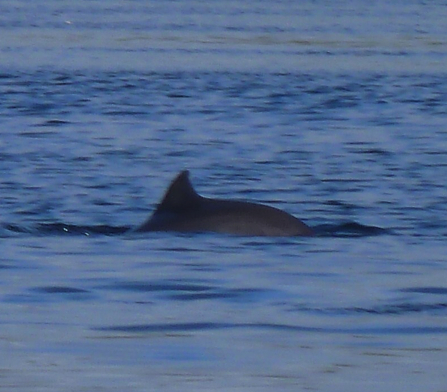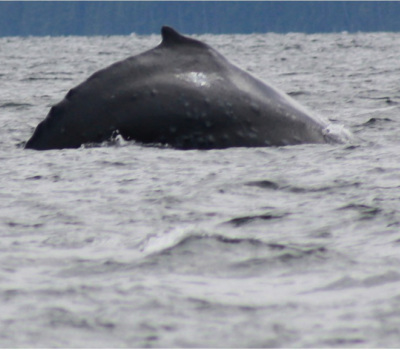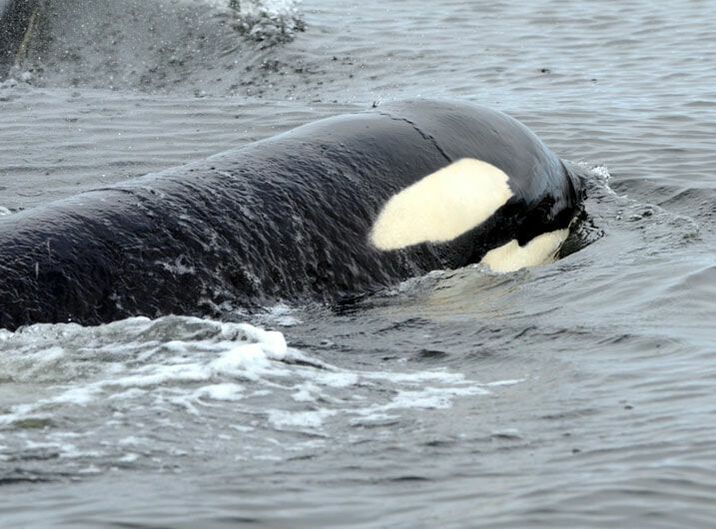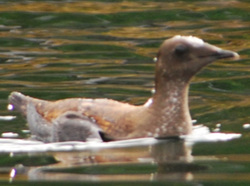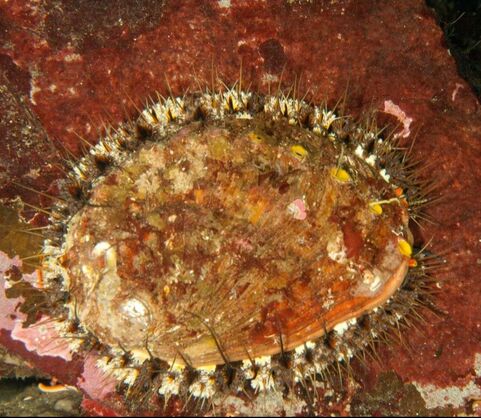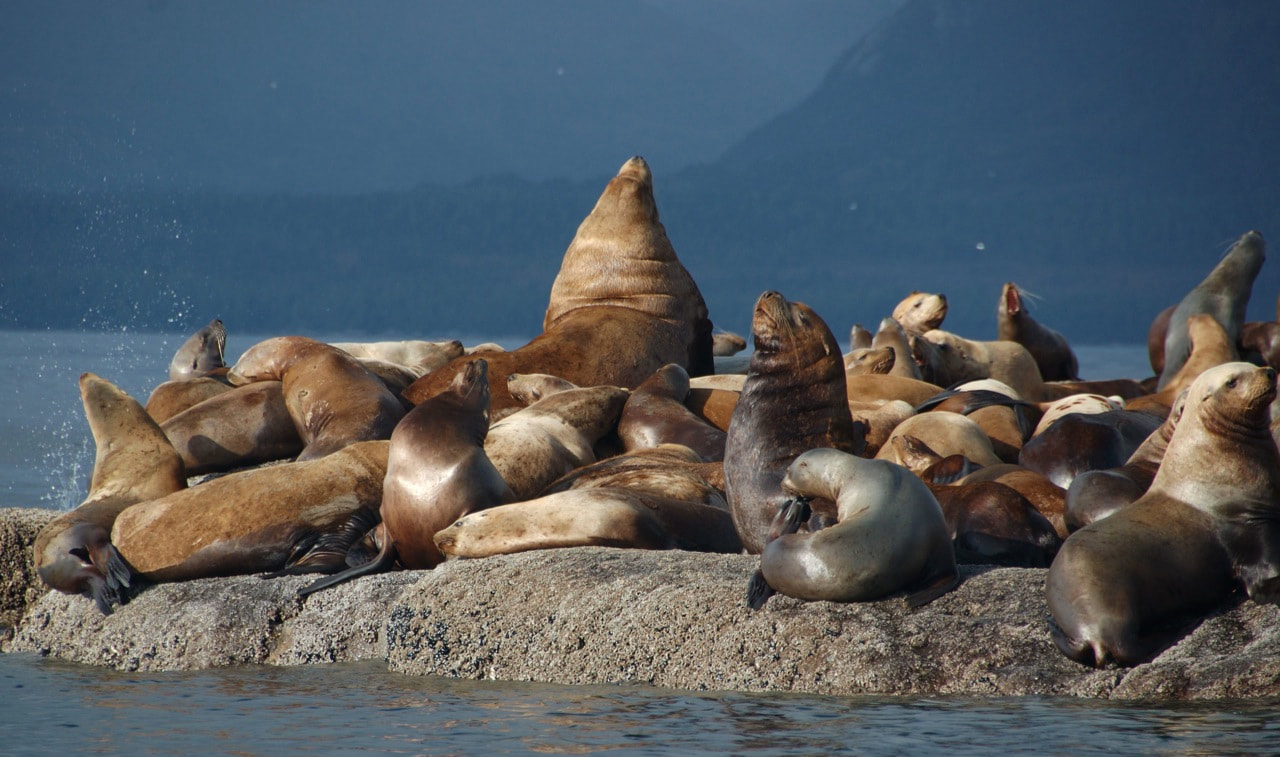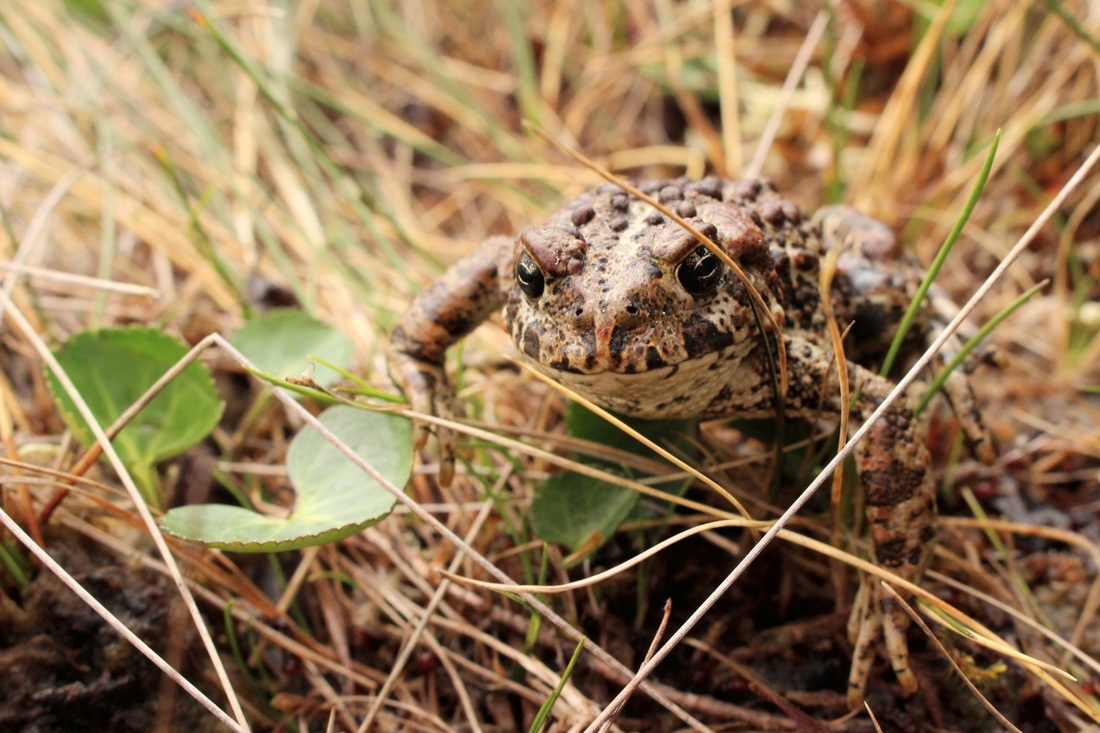Species At Risk
Species at risk are species that are endangered, threatened, extirpated, or of special concern. A description of the provincial and federal species at risk lists can be found below, followed by a list of select species at risk found in BC with information on their listing status and level of protection.
BC Listing
Species that are endangered, threatened, or of concern in BC are classified by the province as red-listed or blue-listed. Red List species are or have populations that are endangered, threatened, or extirpated. Blue List species are of special concern because they have biological or life-history characteristics that make them particularly vulnerable to natural or human-caused disturbance. Species that are are recovering from being threatened or endangered may be blue-listed. Go to the BC Species and Ecosystems Explorer to search these lists.
COSEWIC and SARA
Species may also be listed by the Committee on the Status of Endangered Wildlife in Canada (COSEWIC), though a provincial listing does not necessarily lead to a federal listing. Species listed as endangered, threatened, or of concern by COSEWIC are then recommended for protection under the federal Species At Risk Act (SARA).
Legal Protection
Note that only a listing of endangered, threatened, or of special concern by SARA results in legal protection for the species. COSWIC listings are not a form of legal protection, and do not necessarily translate into protection under SARA. Listing under the provincial system is not currently a form of legal protection either, as BC is one only two Canadian provinces without a separate, stand-alone provincial endangered species law (the other is Alberta). In 2017 the BC government committed itself to creating an endangered species law; this is now in development. BC wildlife does have some protection under other legislation; click here for more information.
The level of protection gained by a successful SARA listing is the subject of scrutiny by some scientists and environmental advocacy groups, and the strength of existing protection may be subject to changes based on politics. Read more about this and about contentious species listings in the following publications:
Species that are endangered, threatened, or of concern in BC are classified by the province as red-listed or blue-listed. Red List species are or have populations that are endangered, threatened, or extirpated. Blue List species are of special concern because they have biological or life-history characteristics that make them particularly vulnerable to natural or human-caused disturbance. Species that are are recovering from being threatened or endangered may be blue-listed. Go to the BC Species and Ecosystems Explorer to search these lists.
COSEWIC and SARA
Species may also be listed by the Committee on the Status of Endangered Wildlife in Canada (COSEWIC), though a provincial listing does not necessarily lead to a federal listing. Species listed as endangered, threatened, or of concern by COSEWIC are then recommended for protection under the federal Species At Risk Act (SARA).
Legal Protection
Note that only a listing of endangered, threatened, or of special concern by SARA results in legal protection for the species. COSWIC listings are not a form of legal protection, and do not necessarily translate into protection under SARA. Listing under the provincial system is not currently a form of legal protection either, as BC is one only two Canadian provinces without a separate, stand-alone provincial endangered species law (the other is Alberta). In 2017 the BC government committed itself to creating an endangered species law; this is now in development. BC wildlife does have some protection under other legislation; click here for more information.
The level of protection gained by a successful SARA listing is the subject of scrutiny by some scientists and environmental advocacy groups, and the strength of existing protection may be subject to changes based on politics. Read more about this and about contentious species listings in the following publications:
Provincial
- Protecting Biodiversity in British Columbia: Recommendations for an endangered species law in B.C. by a species at risk expert panel - Westwood et al., 2018
- Taking Nature's Pulse: The Status of Biodiversity in British Columbia - Biodiversity BC
- A Guide to Canada's Species at Risk Act - Scientists for Species
- Recovering the Species At Risk Act - Mooers et al., 2017, Policy Options
- Science, Policy, and Species At Risk in Canada - Mooers et al., 2010, BioScience
- What is an endangered species worth? Threshold costs for protecting imperilled fishes in Canada - BMSC article by Jess Schultz, with link to full paper (Schultz et al., 2013, Marine Policy)
- Species At Risk - David Suzuki Foundation
Example Species
Below you will find some Central Coast species that are classified as endangered, threatened, or of special concern by any of the BC, COSEWIC, or SARA lists. Species that have been proposed for one or more of these lists may also be included, as the listing process can be lengthy or controversial. Species with large ranges that include the Central Coast region may be listed here as well (eg. Pacific salmon populations). Only a select few species are listed here, as BC is home to more than 1900 plant and animal species at risk.
Report wildlife sightings and incidents - If you spot a species you know to be particularly at-risk or under-studied, please report this information to an authority such as Fisheries and Oceans Canada (DFO), the BC Cetacean Sightings Network, or the Coastal Guardian Watchmen for the purposes of data collection. It is especially important to report an animal in distress. You can also contribute your observations to iNaturalist, a global citizen science tool!
Ancient murrelet • Synthliboramphus antiquus
The ancient murrelet is a blue-listed species in BC, and is listed as a species of special concern by COSEWIC and the Species At Risk Act.
The ancient murrelet is common in some areas, but population levels have declined partly due to predation from intruduced foxes, raccoons, and rats on nesting habitat. Other threats to this species include habitat degradation and oil exposure. See the 2004 COSEWIC Assessment and Update Status Report for more information. |
Barn swallow • Hirundo rusticaBarn swallows are blue-listed in BC. They are designated as threatened by COSEWIC and protected under the Species At Risk Act.
Though this is a widespread species, it has been experiencing relatively quick population declines in many areas in Canada. Decreases in nesting and foraging sites may be impacting populations, but reasons for the extent and speed of the decline are not fully understood. Read the 2011 COSEWIC Assessment and Status Report for more information on these issues. |
Chinook salmon • Oncorhynchus tshawytscha
Multiple Chinook populations are listed by COSEWIC as special concern, threatened, and endangered; search the COSEWIC database for the full list. As of 2019 none of these populations are listed/protected under the Species At Risk Act. The key reasons for population decline and continuing threats vary between populations, but may include impacts from dams on migration routes, historical overfishing, decline in quality of marine and freshwater habitats, continued commercial and recreation harvests, and pollution from resource development.
Coho salmon • Oncorhynchus kisutch
Interior Fraser population
This coho population is listed by COSEWIC as threatened. It is not yet protected under the Species At Risk Act (as of 2019).
This nationally significant population has experienced reductions in numbers of more than 60% as a result of habitat degradation and overfishing. The population has experienced decreased survival in the marine stage of its lifecycle. Threats in its freshwater habitat include invasive species, increased water temperatures and drought, and impacts from land use and urbanization. Read more about the threats to the Interior Fraser coho population in the 2016 COSEWIC Assessment and Status Report.
This nationally significant population has experienced reductions in numbers of more than 60% as a result of habitat degradation and overfishing. The population has experienced decreased survival in the marine stage of its lifecycle. Threats in its freshwater habitat include invasive species, increased water temperatures and drought, and impacts from land use and urbanization. Read more about the threats to the Interior Fraser coho population in the 2016 COSEWIC Assessment and Status Report.
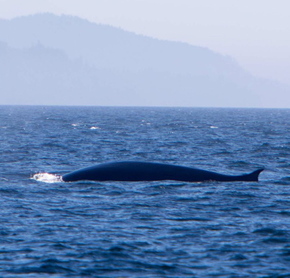
Photo by Brandon Harvey
|
Fin whale • Balaenoptera physalusFin whales are a red-listed species in BC. COSEWIC splits the species into Pacific and Atlantic populations for assessment; the Pacific population is listed as threatened, and the Atlantic population is of special concern.
The Pacific population was severely depleted by whaling in the early 1900's, and is thought to currently be at less than 50% of historic levels. Current threats to this population and its recovery include ship strikes, of which fin whales are a major victim; entanglement in fishing gear, particularly gillnets; and illegal harvesting. Contaminants and noise pollution may also impact this species. Read more about threats to this species in the 2005 COSEWIC Assessment and Update Status Report. |
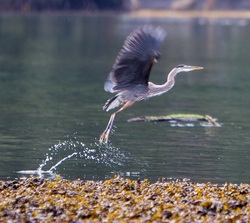
Photo by Brandon Harvey
|
Great blue heron • Ardea herodiasThere are two Ardea subspecies in BC, and both are blue-listed: fannini and herodias. Subspecies fannini is listed as special concern by COSEWIC and the Species At Risk Act.
It is unclear whether the small populations of these subspecies are stable or declining slightly, but in either case habitat degradation is a threat. Development threatens nesting and foraging sites, especially as herons are particularly sensitive to disturbance. Read more about threats faced by great blue herons in the 2008 COSEWIC Assessment and Update Status Report. |
Grizzly bear • Ursus arctosThe western population of grizzly bear is blue-listed in BC and listed by COSEWIC and the Species At Risk Act as a species of special concern.
Some of the issues facing grizzlies in coastal BC are habitat loss, contaminants, trophy hunting, and decreasing stocks of Pacific salmon, as salmon are a major food source for coastal grizzlies. Visit Raincoast Conservation Foundation to learn more about these threats to coastal grizzly populations. |
Harbour porpoise • Phocoena phocoenaHarbour porpoises are blue-listed in BC. They are listed as a species of special concern by COSEWIC and the Species At Risk Act.
Harbour porpoises appear to be particularly vulnerable to human activities. Their main threat is fishing - they can become trapped and killed in fishing nets, particularly those used to catch groundfish (bottom-set gill nets). They are sensitive to environmental contaminants that build up in their food chain such as heavy metals, dioxins, organochlorines, and furans. They are also affected by noise pollution; sources include boat traffic as well as the acoustic harassment devices used around aquaculture sites. Read the 2016 COSEWIC Assessment and Update Status Report for more information on this issues. |
Humpback whale • Megaptera novaeangliaeHumpbacks are a blue-listed species in BC. They are listed as a species of special concern by COSEWIC and the Species At Risk Act.
This population has been undergoing a slow but steady increase since its 1966 legal protection from whaling. Existing threats include ship strikes, entanglement in fishing gear, habitat degradation, and noise disturbance. For more information on threats, read the 2013 SARA Recovery Strategy. |
Killer whale • Orcinus orcaThere are four populations of killer whales in coastal BC waters, and all are red-listed in BC: offshore, transient, southern resident, and northern resident. All are listed by COSEWIC: the southern residents are endangered, and the other three populations are threatened. All are protected under the Species at Risk Act. Search "killer whale" in the COSEWIC database for details.
Some threats include physical and acoustic disturbance from motorized boats, competition for prey (southern resident population), and contaminants. More details can be found in the 2018 Recovery Strategy (resident populations) and the 2008 COSEWIC Assessment and Update Status Report. |
Marbled murrelet • Brachyramphus marmoratusMarbled murrelets are a blue-listed species in BC. They are listed as threatened by COSEWIC and Canada's Species At Risk Act.
Habitat loss is the major threat to marbled murrelets. They nest in habitat only provided by BC's old-growth forests, and this habitat is constantly decreasing in size and quality. Habitat fragmentation, fisheries, and disturbance from shipping lanes are other threats. A more detailed account of threats can be found in the COSEWIC Assessment and Status Report. |
Northern abalone • Haliotis kamtschatkanaNorthern abalone are red-listed in BC. They are listed as endangered by COSEWIC, and are protected as endangered under the Species At Risk Act.
Poaching is the most serious threat to abalone. There has been a moratorium on abalone harvests since 1990, and the species was listed as threatened in 2000. In 2009 its status was changed to endangered. Other concerns are low densities — abalone are broadcast spawners, so low densities impact reproduction — and predation by recovering sea otter populations. Read more about these threats in the 2009 COSEWIC Assessment and Update Status Report and the 2007 SARA Recovery Strategy. |
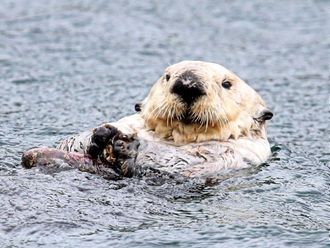
Photo by Erin Rechsteiner/Hakai Institute.
|
Sea otter • Enhydra lutrisSea otters are blue-listed in BC. They are listed as a species of special concern by COSEWIC and the Species At Risk Act. In 2007 their status was lowered to special concern from threatened.
Sea otters have repopulated a significant amount of their historic range, but numbers are still small and the species is vulnerable to a number of threats. The biggest threat to sea otter recovery is the possibility of oil spills, as their habitat overlaps with oil tanker routes and they are particularly susceptible to the effects of oil. Read more about the threats to sea otters in the 2007 COSEWIC Assessment and Update Status Report, and the 2007 SARA Recovery Strategy. |
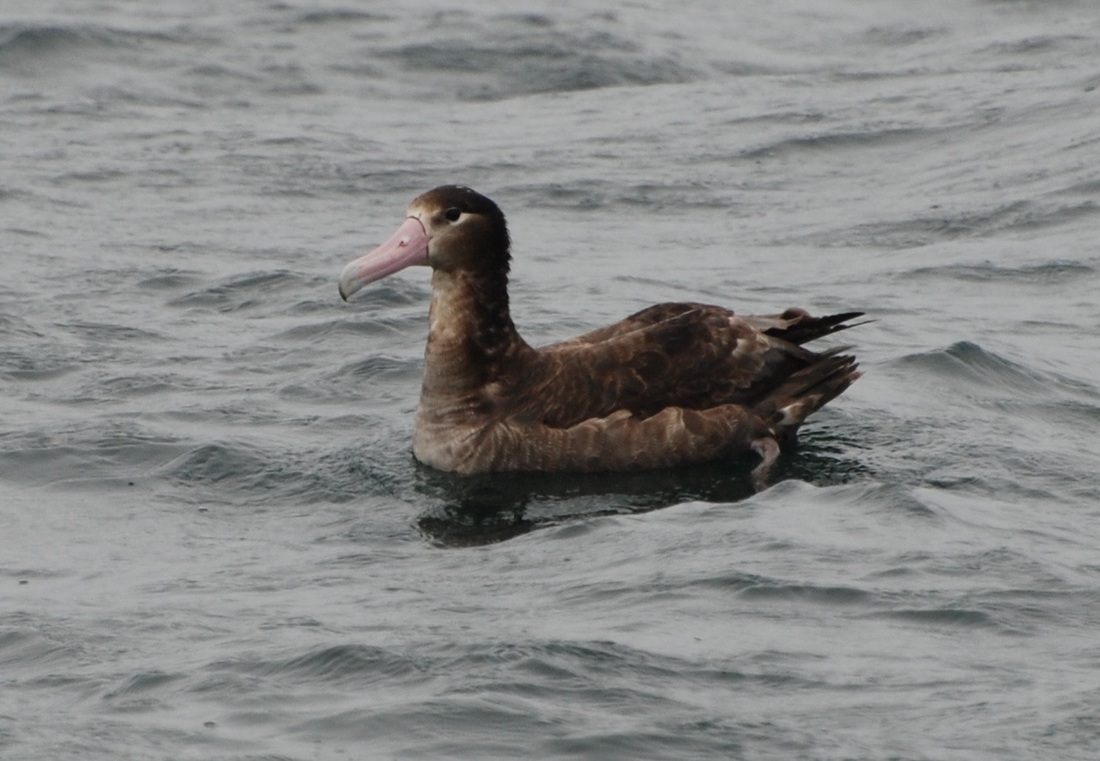
Photo by Caroline Fox of
Raincoast Conservation Foundation. |
Short-tailed albatross • Phoebastria albatrusShort-tailed albatrosses are red-listed in BC, and are designated as threatened by COSEWIC (2013). They are protected under Canada's Species At Risk Act.
Until the early 20th century short-tailed albatrosses were harvested at breeding colonies for their feathers. This caused a drastic population decline; they are now vulnerable to a number of other threats due to their low population numbers and small breeding range. Threats include oil pollution, bioaccumulation of pollutants, plastic ingestion, and entanglement in fishing gear. See the 2003 COSEWIC Assessment and Status Report for more information. |
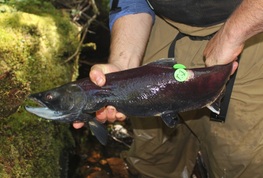
Sockeye salmon • Oncorhynchus nerka
Multiple sockeye populations are listed by COSEWIC as special concern, threatened, and endangered; search the COSEWIC database for the full list. As of 2019 none of these populations are listed/protected under the Species At Risk Act. The key reasons for population declines and continuing threats vary between populations, but may include habitat loss and degradation, overfishing, industrial pollution, and warming temperatures in freshwater habitats.
Multiple sockeye populations are listed by COSEWIC as special concern, threatened, and endangered; search the COSEWIC database for the full list. As of 2019 none of these populations are listed/protected under the Species At Risk Act. The key reasons for population declines and continuing threats vary between populations, but may include habitat loss and degradation, overfishing, industrial pollution, and warming temperatures in freshwater habitats.
Steller sea lion • Eumetopias jubatusSteller sea lions are blue-listed in BC. They are listed as a species of special concern by COSEWIC and the Species At Risk Act.
The population is increasing, but this could change quickly in the event of a large oil spill. They are also easily disturbed by humans while on land. Details on their status and potential threats can be found in the 2014 COSEWIC Assessment and Update Status Report. |
Western toad • Anaxyrus boreasWestern toads are blue-listed in BC. They are listed as a species of special concern by COSEWIC and the Species At Risk Act. The species was listed in 2002, and in 2012 was split into the calling and non-calling populations for assessments.
Threats to western toads include the amphibian chytrid fungus, to which they are particularly sensitive, as well as habitat destruction and fragmentation by urban and agricultural development. Read more about these threats in the 2012 COSEWIC Assessment and Status Report. |
Authors and editors of page
Kelly Fretwell and Brian Starzomski (2013).
Kelly Fretwell and Brian Starzomski (2013).
